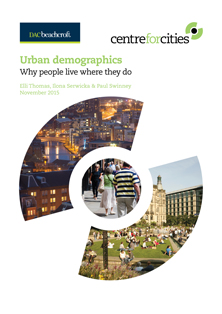00Executive Summary
Urban and rural, town and country – cities are often seen as islands. But the role that they play does not stop at administrative boundaries. People living in rural areas still rely on cities for jobs, shops and amenities – and people choose to live in and around cities, in vibrant city centres, leafy suburbs, and quiet villages, for all sorts of reasons.
This research looks at why people choose to live where they do in and around cities. Using data from national and local YouGov polling commissioned for the research, it finds that:
- City centre residents, who are likely to be young, single students or professionals, said that they live there to be close to restaurants, leisure and cultural facilities, to public transport, and to their workplace.
- Residents in suburbs, who tend to be over 30 with children, said they live there because of the cost, size and type of their housing, to be close to good schools, and because of the safety and security of the neighbourhood.
- In rural hinterlands, which tend to be home to the over 55s, people surveyed primarily chose to live there to be close to countryside and green spaces.
While the demographic profile of residents in suburbs and hinterlands – and the reasons given for why they live there – tend to be similar across cities, there is much greater variation between city centres.
This is particularly interesting considering the remarkable return to city centre living that has occurred in recent years. In the 1970s and 80s, city centres across England and Wales hollowed out, as people retreated from deindustrialising cities to the suburbs. But these trends have reversed since 1991, and growth has accelerated since 2001. The population of city centres grew by 37 per cent between 2001 and 2011, significantly faster than suburbs and hinterlands, which grew by 8 per cent and 6 per cent respectively.
The return to city centre living has been led by big cities. The populations of city centres in large cities doubled between 2001 and 2011, principally driven by students and young professionals. The survey results suggest this was because of access to work, culture and leisure facilities. But the growth of populations of many small and medium-sized cities has been slower, and has been driven by families and workers in non-professional occupations. The polling suggests that those choosing to live in these city centres have done so because of the availability of cheaper housing, rather than the proximity of jobs and other amenities.
What does this mean for the future of residential living? The growing demand to live in city centres is linked to the ever increasing presence of well-paid, knowledge-based jobs in these areas. And given that these jobs are likely to continue to grow in city centres in the future, demand for city centre living is likely to increase too, pushing up house prices, and creating competition for land between housing and offices. Meanwhile, some of the drawbacks of city centre living highlighted in the survey – such as pollution and a lack of green spaces – will likely be exacerbated too, requiring proactive thinking to prevent them becoming a constraint on growth.
In smaller cities, where city centres have not played the same role as places to work or to live, any future plans to regenerate or improve the city centre will need to think beyond regeneration strategies that focus on buildings alone, as these have not been particularly successful in attracting either jobs or residents to city centres. Instead, regeneration policy should focus on improving city centres as places to do business, as well as reconsidering the role played by universities.
The report has five key policy recommendations:
1. Planning strategically across city regions
People live out their lives across city regions and need different things from different places. Integrating housing, transport and public services requires strategic planning and transport powers at combined authority level, similar to those granted in London and Manchester.
2. Putting economic development at the heart of regeneration strategies
City centre regeneration strategies have often focused on physical and cultural development – but these alone do not provide the things that people need from the places where they live. Economic development needs to be at the heart of any successful city centre regeneration strategy.
3. Extending Permitted Development Exclusion Zones
In growing city centres, meeting increasing demand for both office space and housing will be crucial for supporting growth. Extending Permitted Development Exclusion Zones into more high demand city centres would help to retain the balance between valuable office space and housing.
4. Maximising student presence in city centres
Student populations in city centres can play a role in supporting local amenities. Universities in places that have a struggling city centre should review their property portfolios and increase their presence in the city centre where possible – either through city centre campuses or new student accommodation.
5. Mitigating the drawbacks of city centre life: managing pollution and open spaces
City centre residents accept high pollution and few green spaces in order to enjoy city centre living. But as city centres grow, these drawbacks could become deterrents and hold back growth. Cities with growing city centres will need to do more to mitigate these effects – by reducing emissions through sustainable transport strategies, and by actively incorporating parks and open spaces in new developments.
